Introduction to Natural and Common Logarithms
Learning Objectives
- Use a calculator to find logarithms or powers of base `e`.
- Graph exponential and logarithmic functions of base `e`.
- Find logarithms to bases other than `e` or `10` by using the change of base formula.
Introduction
In both exponential functions and logarithms, any number can be the base. However, there are two bases that are used so frequently that mathematicians have special names for their logarithms, and scientific and graphing calculators include keys specifically for them! These are the common and natural logarithms.
Common Logarithms and `e`
A common logarithmA logarithm using `10` as the base, such as `log_10`. is any logarithm with base `10`. Recall that our number system is base `10`; there are ten digits from `0` through `9`, and place value is determined by groups of ten. You can remember a “common logarithm,” then, as any logarithm whose base is our “common” base, `10`.
Natural logarithmsA logarithm that uses `e` as the base (`log_e`). are different than common logarithms. While the base of a common logarithm is `10`, the base of a natural logarithm is the special number eAn irrational number, approximately `2.718281828459`; sometimes called Euler’s number.. Although this looks like a variable, it represents a fixed irrational number approximately equal to `2.718281828459`. (Like pi, it continues without a repeating pattern in its digits.) `e` is sometimes called Euler′s number or Napier’s constant, and the letter `e` was chosen to honor the mathematician Leonhard Euler (pronounced oiler).
`e` is a complicated but interesting number. Let’s take a closer look at it through the lens of a formula you have seen before: compound interest.
The formula for compound interest is `A=P(1+r/m)^(mt)`, where `A` is the amount of money after `t` years, `P` is the principal or initial investment, `r` is the annual interest rate (expressed as a decimal, not a percent), `m` is the number of compounding periods in a year, and `t` is the number of years.
Imagine what happens when the compounding happens frequently. If interest is compounded annually, then `m = 1`. If compounded monthly, then `m = 12`. Compounding daily would be represented by `m = 365`; hourly would be represented by `m = 8,760`. You can see that as the frequency of the compounding periods increases, the value of `m` increases quickly. Imagine the value of `m` if interest were compounded each minute or each second!
You can even go more frequently than each second, and eventually get compounding continuously. Look at the values in this table, which looks a lot like the expression multiplied by `P` in the above formula. As `x` gets greater, the expression more closely resembles continuous compounding.
|
`x`
|
`(1+1/x)^x`
|
|
`1`
|
`2`
|
|
`10`
|
`2.59374...`
|
|
`100`
|
`2.70481...`
|
|
`1000`
|
`2.71692...`
|
|
`10,000`
|
`2.71814...`
|
|
`100,000`
|
`2.71826...`
|
|
`1,000,000`
|
`2.71828...`
|
Notice that although `x` is increasing a lot (multiplying by `10` each time!), the value of `(1+1/x)^x` is not increasing wildly. In fact, it is getting closer and closer to `2.718281828459...`or the value now called `e`.
The function `f(x) = e^x` has many applications in economics, business, and biology. `e` is an important number for this reason.
Working with Bases of `e` and `10`
Scientific and graphing calculators all have keys that help you work with `e`. Look on your calculator and find one labeled “`e`” or “exp.” (Some graphing calculators may require you to use a menu to find `e`. If you can’t see the key, consult your manual or ask your instructor.)
How to evaluate exponential expressions using `e` (such as `e^3`) depends on your calculator. On some calculators, you have to press the [`e^x`] key first then enter the exponent and press enter. On others you enter the exponent first then press the [`e^x`] key. It is important that you know how your calculator works. With your calculator, try finding `e^3`. The result should be `20.0855369...` (the number of digits displayed will also depend on your calculator).
|
Example
|
|
Problem
|
Find `e^1.5` using a calculator. Round your answer to the nearest hundredth.
|
|
|
|
Enter the keystrokes needed for your calculator. If you are having trouble getting the correct answer, consult your manual or instructor.
|
|
|
`4.4816890...`
|
Calculator result. Then round the answer to the nearest hundredth.
|
|
Answer
|
`4.48`
|
To see this worked out on a calculator, see the Worked Examples for this topic.
|
You can find powers of `10` (the common base) in the same way. Some calculators have a [`10"^"`] or [`10^x`] key that you can use to find powers of `10`. Another way to find powers of `10` is to use the [`x^y`] or the [`y^x`] key that will work with any base (although if you use this method, you will have to key in two numbers: the base, `10`, and whatever exponent you are raising it to).
|
Example
|
|
Problem
|
Find `10^1.5`, using a calculator. Round your answer to the nearest hundredth.
|
|
|
|
Enter the keystrokes needed for your calculator. If you are having trouble getting the correct answer, consult your manual or instructor.
|
|
|
`31.6227766...`
|
Calculator result. Then round the answer to the nearest hundredth.
|
|
Answer
|
`31.62`
|
To see this worked out on a calculator, see the Worked Examples for this topic.
|
Natural logarithms (using `e` as the base) and common logarithms (using `10` as the base) are also available on scientific and graphing calculators. When a logarithm is written without a base then you should assume the base is `10`. For example:
`log100 = log_10 100=2`
Natural logarithms also have their own symbol: `ln`.
`ln 100 = log_e 100=4.60517...`
The logarithm keys are often easier to find, but they may work differently from one calculator to the next. Most handheld scientific calculators require you to provide the input first, then press the [log] (common) or [`ln`] (natural) key. Other calculators work in reverse: press the [log] or [ln] key, and then provide the input and press [Enter] or [`=`].
On your calculator, find the common logarithm ([log] or [`log_10`]) key and the natural logarithm ([`ln`]) key and verify that `ln 100 = log_e 100=4.60517...`.
|
Example
|
|
Problem
|
Find `ln 3`, using a calculator. Round your answer to the nearest hundredth.
|
|
|
|
Remember `ln` means “natural logarithm,” or `log_e`. Enter the keystrokes needed for your calculator. If you are having trouble getting the correct answer, consult your manual or instructor.
|
|
|
`1.098612...`
|
Calculator result. Then round the answer to the nearest hundredth.
|
|
Answer
|
`1.10`
|
To see this worked out on a calculator, see the Worked Examples for this topic.
|
|
Example
|
|
Problem
|
Find `log 34`, using a calculator. Round your answer to the nearest hundredth.
|
|
|
|
Remember, when no base is specified, this is the common logarithm (base `10`). Enter the keystrokes needed for your calculator. If you are having trouble getting the correct answer, consult your manual or instructor.
|
|
|
`1.5314789...`
|
Calculator result. Then round the answer to the nearest hundredth.
|
|
Answer
|
`1.53`
|
To see this worked out on a calculator, see the Worked Examples for this topic.
|
|
Use a calculator to find `ln 7`.
A) `0.845098...`
B) `1.945910...`
C) `1096.633...`
D) `10,000,000`
A) `0.845098...`
Incorrect. You found the value of `log 7`, that is, `log_10 7`. The correct answer is `1.945910...`.
B) `1.945910...`
Correct. You correctly identified the keys on your calculator and found the natural log of `7`.
C) `1096.633...`
Incorrect. You found the value of `e^7`. The correct answer is `1.945910...`.
D) `10,000,000`
Incorrect. You found the value of `10^7`. The correct answer is `1.945910...`.
|
Graphing Exponential and Logarithmic Functions of Base `e`
Graphing functions with the base `e` is no different than graphing other exponential and logarithmic functions: create a table of values, plot the points, and connect them with a smooth curve. You will want to use a calculator when creating the table.
|
Example
|
|
Problem
|
Graph `f(x) = e^x`.
|
|
|
|
|
`x`
|
`f(x)`
|
|
`-2`
|
`0.1353...`
|
|
`-1`
|
`0.3678...`
|
|
`0`
|
`1`
|
|
`1`
|
`2.7182...`
|
|
`2`
|
`7.3890...`
|
|
Start with a table of values. Don’t forget to choose positive and negative values for `x`.
Use a calculator to find the `f(x)` values.
|
|
|
|
`(x,y)` pairs
|
|
`(-2, 0.1353...)`
|
|
`(-1, 0.3678...)`
|
|
`(0, 1)`
|
|
`(1, 2.7182...)`
|
|
`(2, 7.3890...)`
|
|
If you think of `f(x)` as `y`, each row forms an ordered pair that you can plot on a coordinate grid.
|
|
|
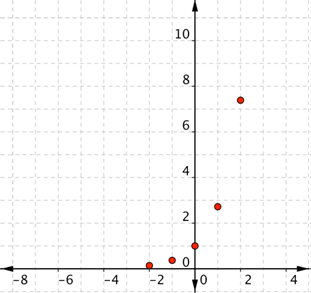
|
Plot the points.
|
|
Answer
|
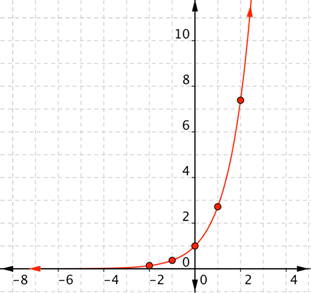
|
Connect the points as best you can, using a smooth curve (not a series of straight lines). Use the shape of an exponential graph to help you: the graph gets close to the `x`-axis on the left, and gets steeper and steeper on the right.
|
The same process works for logarithmic functions. Choose `x` values and use a calculator to find the `y` values.
|
Example
|
|
Problem
|
Graph `f(x) = ln x`.
|
|
|
|
|
`x`
|
`f(x)`
|
|
|
`0.1`
|
`-2.30...`
|
|
`0.5`
|
`-0.69...`
|
|
`1`
|
`0`
|
|
`e`
|
`1`
|
|
`5`
|
`1.60...`
|
|
`10`
|
`2.30...`
|
|
Start with a table of values. If you choose `x` values, remember that `x` must be greater than `0`. Choose values greater than and less than the base (the base and `1` are also good choices for `x` values).
|
|
|
|
`(x,y)` pairs
|
|
`(0.1, -2.30...)`
|
|
`(0.5, -0.69...)`
|
|
`(1, 0)`
|
|
`(e, 1)`
|
|
`(5, 1.60...)`
|
|
`(10, 2.30...)`
|
|
If you think of `f(x)` as `y`, each row forms an ordered pair that you can plot on a coordinate grid.
|
|
|

|
Plot the points.
|
|
Answer
|

|
Connect the points as best you can, using a smooth curve (not a series of straight lines). Use the shape of a logarithmic graph to help you: the graph gets close to the `y`-axis for `x` near `0`.
|
Sometimes the inputs to the logarithm, or the exponent on the base, will be more complicated than just a single variable. In those cases, be sure to use the correct input on the calculator.
Note: If your calculator uses the “input last” method for logarithms, either calculate the input separately and write it down, or use parentheses to be sure the correct input is used. For example, when calculating `log(3x)` when `x = 4`, the correct answer is `1.079...` . If you don’t use the parentheses, the calculator will find `log 3`, and multiply that by `4` to get `1.908...` .
|
Example
|
|
Problem
|
Graph `f(x) = ln4x`.
|
|
|
|
|
`x`
|
`4x`
|
`f(x)`
|
|
`0.1`
|
`0.4`
|
`-0.91...`
|
|
`0.5`
|
`2`
|
`0.69...`
|
|
`1`
|
`4`
|
`1.38...`
|
|
`3`
|
`12`
|
`2.48...`
|
|
`10`
|
`40`
|
`3.68...`
|
|
Create a table of values. Although everything could be done using the calculator, let’s include a column for the input of the logarithm. This helps you avoid calculator errors.
|
|
|
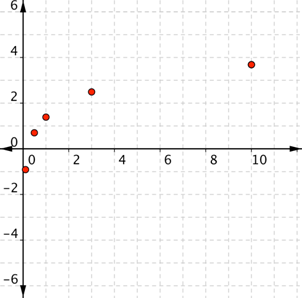
|
Use the table pairs to plot points. You may want to choose additional values for the table to give a better idea for the entire visible graph.
|
|
Answer
|
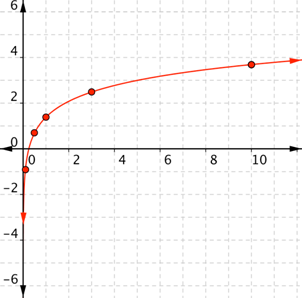
|
Connect the points as best you can, using a smooth curve.
|
|
Which of the following is a graph for `f(x)=e^(0.5x)`?
A)

B)
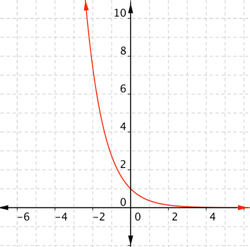
C)
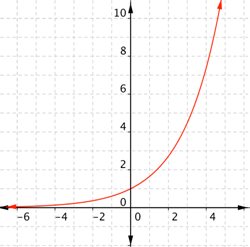
D)
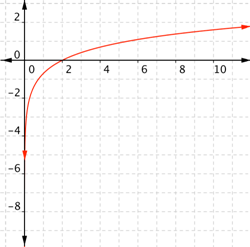
A)
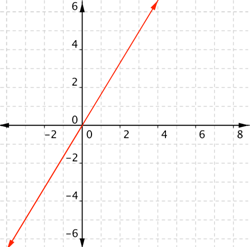
Incorrect. This is a linear graph. It’s actually `f(x)=(e^(0.5))x`. The correct answer is Graph C.
B)
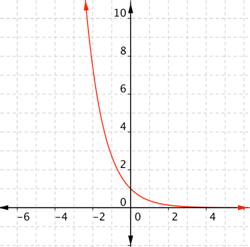
Incorrect. This graph is decreasing, while `f(x) = e^(0.5x)` is increasing. The correct answer is Graph C.
C)
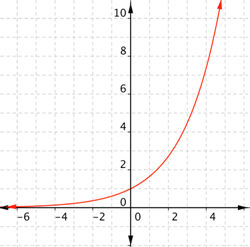
Correct. This graph accurately shows `f(x)=e^(0.5x)`.
D)
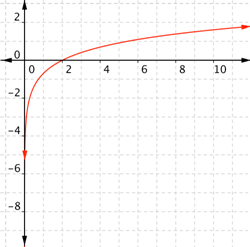
Incorrect. This is a graph of `f(x) = ln(0.5x)`. The correct answer is Graph C.
|
Finding Logarithms of Other Bases
Now you know how to find base `10` and base `e` logarithms of any number. What if you wanted to calculate `log_7 36`? Converting to an exponential equation, you have `7^x=36`. You know `7^1` is `7`, and `7^2` is `49`, so you can reason that `x` must be between `1` and `2`, probably very close to `2`. But how close? You don’t have a key for base `7`, so you use a Change of Base formula to change the base of a log function to another base.
|
Change of Base formula
`log_bx=log_ax/log_ab`
|
Notice that `a` appears as the base in both logarithms on the right side of the formula. For example, `log_7 36=log36/log7`, using a new base of `10`. You could also say `log_7 36=ln36/ln7`, or even `log_7 36=log_362 36/log_362 7`. Of course, that last one isn’t any easier to calculate than the original expression, but using the [log] or [`ln`] keys on a calculator, you can use `log36/log7` or `ln 36/ln 7` to find `log_7 36`.
|
Example
|
|
Problem
|
Find `log_7 36`.
|
|
|
|
`log_7 36=log36/log7`
|
Use the Change of Base formula. You can use common logarithms or natural logarithms. For this example, let’s use common logarithms.
|
|
|
`log36/log7=(1.55630...)/(0.84509...)=1.84156...`
|
Use the calculator to evaluate the quotient.
|
|
Answer
|
`1.84156...`
|
|
If you had used natural logarithms, you would have gotten the same answer:
`log_7 36=ln 36/ln 7=(3.5835...)/(1.9459...)=1.84156...`
|
Example
|
|
Problem
|
Find `log_3 25.9`.
|
|
|
|
`log_3 25.9=ln 25.9/ln 3`
|
Use the Change of Base formula. This time, let’s use natural logarithms.
|
|
|
`ln 25.9/ln 3=(3.2542...)/(1.0986...)=2.9621...`
|
Evaluate the quotient.
|
|
Answer
|
`2.9621`
|
|
|
Find `log_5 200`.
A) `40`
B) `0.303...`
C) `3.292...`
D) `2.301...`
A) `40`
Incorrect. You found the value of `200 ÷ 5`. The correct answer is `3.292...`.
B) `0.303...`
Incorrect. When using the Change of Base formula, the log of the original base is the denominator: `log_5 200=log200/log5=ln200/ln5`. The correct answer is `3.292...`.
C) `3.292...`
Correct. `log_5 200=log200/log5=ln200/ln5=3.292...`
D) `2.301...`
Incorrect. You found the value of `log 200`. The correct answer is `3.292...`.
|
Summary
Common logarithms (base `10`, written `logx` without a base) and natural logarithms (base `e`, written `ln x`) are used often. Scientific and graphing calculators have keys or menu items that allow you to easily find `logx` and `ln x`, as well as `10^x` and `e^x`. Using these keys and the change of base formula, you can find logarithms in any base.













